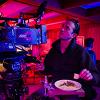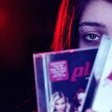-
Posts
1,538 -
Joined
-
Last visited
About Mark Kenfield

Profile Information
-
Occupation
Cinematographer
-
Location
Australia/Wherever The Wind Takes Me
-
My Gear
Arri Alexa Studio, Zeiss CZ.2 Compact Zooms
-
Specialties
I'm makin' movies, singin' songs and light'n round the world.
Contact Methods
-
Website URL
http://www.dreamsmiths.com.au
Recent Profile Visitors
-
The easiest way to calibrate (or at least check) your light meter these days, is to grab a camera, and use it's false-colour mode to check whether your meter is giving you accurate readings. I do this before any big shoot, and even 13-years on, my trusty, beat-up L758-C is still giving me accurate readings.
-
Mark Kenfield started following WTB: Arri VEB-1 Viewfinder Extension Bracket
-
Hi everyone, I'm trying to track down an old VEB-1 viewfinder extension bracket for the classic Alexas. If anyone has one sitting around that they'd be happy to send to a new home. Please let me know. Also potentially open to trading one for the newer VEB-3 that I currently have. I'm based in Melbourne, Australia, but happy to ship one in from wherever. Cheers
-

The current state of 16mm shooting in Australia
Mark Kenfield replied to Patrick Cooper's topic in Film Stocks & Processing
I'm a little surprised that you'd be "shocked". The celluloid industry here collapsed almost overnight with the arrival of viable digital cinema production. It started declining rapidly in 2008 with the arrival of the Red One and 5D MkII, and the coffin was sealed as soon as the Alexa arrived in 2010 (along with the widespread adoption of 2k Digital Projection). The labs all collapsed, and the only gear that wasn't sold off or scrapped, was bought up by a few tokens individuals who valued the history of it. So there's been almost no celluloid infrastructure down here for over a decade. For quite a few years, we were having to send film over to Singapore for processing - until a few small operations opened up again to cater to the limited demand that still remained. 16mm has been seeing something of a resurgence locally over the last few years, as hip (predominantly Gen-Z) cinematographers have been exploring it for music videos and a bit of commercial work. There's very little use of it reaching narrative production (outside of the odd short film). But the important point is - you can shoot and process S16mm locally these days, and get it scanned at high quality. I have a couple of rolls of 7207 sitting in the fridge that I'd love to use up before they become completely useless - so if you can get the song together I'd love to get involved! It's not easy to convince people of the aesthetic value of it these days. -

Killers of the Flower Moon
Mark Kenfield replied to Stephen Perera's topic in On Screen / Reviews & Observations
Saw it last night and really enjoyed the experience. Very engaging and it didn't feel over-long or drawn-out (which is something I felt very strongly with Silence). Looked fantastic (never a surprise with Rodrigo behind the camera). I particularly loved the look of the daytime exteriors - which felt rather more "lit" than the average daytime exterior these days - I thought it was a lovely, it wasn't obvious and didn't draw your eye to it, but it felt like you could really see everything. There was one scene that I couldn't quite wrap my head around the lighting for though. In the saloon/cafe where Ernest gets arrested. The location had big windows, but the action started so deep in this (really quite dark-walled) room, and then moved right up next to the windows, and the exposure was just perfectly even throughout (with the windows never blowing out). I'd love to know how they did that, I'm sure it can't have been anything as simple as an iris-pull. -

Is The Fluid Head Obsolete?
Mark Kenfield replied to Marcos Cooper's topic in Camera Operating & Gear
Cameras certainly move more now than they used to, with handheld being a far more dominant style than ever before. But tripods are going nowhere, and still form the backbone of most production (outside of perhaps the largest and lowest budget productions).- 18 replies
-
- tripod
- fluid head
-
(and 2 more)
Tagged with:
-
From all of the tests I saw when the digital transition started happening, S35mm appeared to resolve approximately 3k in horizontal resolution. More than 2k, less than 4k. If I'm remembering correctly, I think most of those comparison tests were generally shot on 200 ASA stocks. So I'm sure you'd probably resolve a little more on low-grain 50 ASA stock, and a little less on 500 ASA. But at 200 ASA, the grain structure stopped revealing any additional detail at about the 3k mark. I think this is part of the reason the Alexa was so effective at replacing celluloid, because you weren't really giving up anything in capture resolution. From my own tests comparing scanned 35mm full-frame film to early DSLR cameras, I found that at 200 ASA, a 12-megapixel digital sensor effectively matched a scanned frame of 135 for resolvable detail. That was the point at which I bought my first digital camera (the Nikon D300). If you run the math, 12-megapixels (approximately 4300 pixels wide) at a full-frame aperture, scales down to approximately 2900 pixels wide at a S35mm aperture. So my tests (on stills stock) would seem to align pretty well with the tests on motion picture stock. Now obviously there are some added elements to all this. You can blow up a S35mm celluloid image, much further than a digital image of equivalent resolution - because the grain structure doesn't break down into nasty individual pixels in the same way as a digital image does. So to compare them in terms of resolution, you really do need to talk about "resolvable detail", and on that front about 3k pixels wide for a S35mm frame does seem to be roughly the point of equivalence between the two.
-

Out of the Blue (1980)
Mark Kenfield replied to Mark Kenfield's topic in On Screen / Reviews & Observations
Thanks David, I'll check them out ? -
Just saw this trailer for the restoration of Out of the Blue (1980) directed by Dennis Hopper. Not a film I've heard of before, but I was kind of shocked by how contemporary Marc Champion's cinematography looks. Extremely naturalistic lighting (with soft/invisible/ambient keys), lots of shallow focus lensing (even outdoors) and the liberal use of handheld. It's got me thinking, what were the very first pictures to embrace these contemporary sensibilities that have now become the default?
-
Hi, how many hours on the body? And what model is the battery plate?
-

At The Time Reaction to Attack Of The Clones?
Mark Kenfield replied to Max Field's topic in General Discussion
That film was far too awful to pay much attention to the images. -

The Perfect Interview Key Light - Godox F600Bi
Mark Kenfield replied to Tim Tyler's topic in Lighting for Film & Video
As an ultra low-footprint key, it sounds like a pretty great option. Is there a decent, reasonably painless softbox option for it? -

Shooting a whole Movie at a given F stop?
Mark Kenfield replied to Abdul Rahman Jamous's topic in Lighting for Film & Video
That strikes me as a pretty bonkers concept really. What if you have a really close-focus shot? If you're shooting at a wider aperture, your longer-lens shots will have stupidly shallow DOF. If "consistency" is the goal. Altering your aperture to keep DoF feeling similar between shots (regardless of focal length or subject distance) is going to be a far more effective tool (in my opinion). But Gordie seemed to do just fine for himself (whatever the approach might have been), so what do I know ? -
One of the absolute trailblazers of contemporary cinematography. The world just got a stop darker. RIP.
-

I caught a weird effect on camera. Which one?
Mark Kenfield replied to Vitor Delduque's topic in General Discussion
I'd have pegged it for a LongGOP encoding artifact of some kind? What format did you record in?







